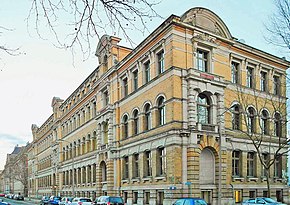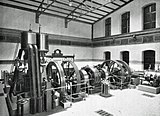Municipal trade school Leipzig

The Leipzig Municipal Trade School was a higher-level part-time school. Numerous name changes, connections with other institutions as well as level increases and profile adjustments ultimately led to today's University of Technology, Economics and Culture Leipzig .
history
In 1875, in view of the rapid development of industry and trade, the city of Leipzig decided to build a school in which personnel were trained in a higher quality in a practical manner than through apprenticeships in the company and the compulsory vocational school, which was becoming naturalized and only imparted general knowledge. On May 3, 1875, the municipal trade school began operations in competition with the already existing private facilities of the Sunday school of the Freemason Lodge Balduin zur Linde and the Sunday trade school of the Leipzig Polytechnic Society, initially in two rooms in a rear building on Lortzingstrasse. Due to the great popularity, the move to twelve rooms of the III. Citizens' school on Johannisplatz.
In the first few years, the school's organizational plan provided for the voluntary attendance of a one-year day course with 36 hours per week and two subsequent evening courses (semester) each with 14 hours per week in order to achieve a qualification. The school fee for this was 20 or 10 Marks per year and could also be waived in emergencies.
The painter and photographer Ludwig Nieper (1826–1906), who was also director of the Academy of Fine Arts, was appointed founding director of the municipal trade school . The school curriculum was varied, but was dominated by drawing lessons, as Nieper saw spatial-vivid thinking as the basis of all technical education. Mathematics and natural sciences were not viewed according to their importance, although with the appointment of August Föppl (1854-1924) in 1877 as a teacher of algebra and technical mechanics, good prerequisites were given until his departure in 1892.
With the incorporation of guild technical schools, such as those for book printers, decorative painters and carpenters, the space requirement had increased so much that the city decided to build a new building. It was built on Wächterstrasse until 1891 according to plans by the Leipzig architect Hugo Licht (1841–1923) and made up the ample half of the current building; the second part followed in 1903. The total length of the three-story building with two short side wings is 100 meters. In addition to the classrooms, it housed numerous studios, workshops and machine rooms.
In 1893 Ludwig Nieper was replaced and the architect Paul Schuster became the director of the school for 30 years until his retirement, at which he had been working as a teacher since 1888 in addition to his duties in the city's structural engineering department. He took account of the increasing demand in industry for technically trained personnel and intensified training in mechanical engineering. In 1896 the municipal mechanical engineering school became independent in the association of the municipal trade school.
The number of teachers at the vocational school grew to around 100 in the 1920s, around half of whom were permanent employees. Individual areas of the school became increasingly independent, so that one soon spoke of the "two top arts and crafts school and mechanical engineering school".
In 1923 Dipl.-Ing. H. Trost from Berlin director of the trade school and in 1925, on the 50th anniversary of its founding, announced the city's resolution that the trade schools should now be run under the name of the Technical Training Institutes of the City of Leipzig . Those were
- the higher mechanical engineering school with the departments for mechanical engineering, industrial engineering, electrical engineering and precision mechanics,
- the higher trade school for the metal industry with an attached master school and technical college,
- the arts and crafts school with the departments of interior design, cabinet making, art turning, wood and stone carving, ceramics and decorative painting,
- the crafts school for art and construction trades , as well as the carpenter's apprenticeship school and the painter's apprenticeship school .
Each of these schools had its own teaching staff and director of studies. H. Trost became director of the technical schools of the city of Leipzig and director of studies of the arts and crafts school. This officially ended the existence of the Leipzig City Trade School.
Further course
In 1932, the technical institutes of the city of Leipzig were renamed the higher technical institutes of the city of Leipzig ; W. Trost remained the director. Between 1929 and 1935 the arts and crafts school and the building trade school were spun off from the school association. The school association concentrated on higher engineering education.
After the Second World War , engineering training began again in 1946, from 1947 under the name of Engineering School for Metal and Electronics . The name changes followed in 1954 Technical School for Heavy Mechanical Engineering , 1956 Engineering School for Heavy Mechanical Engineering and Electrical Engineering and 1964 Engineering School for Mechanical Engineering and Electrical Engineering . The latter became the engineering school for automation technology in 1964 through the merger with the engineering school for chemistry and the Leipzig-Dölitz branch of the engineering school for precision engineering in Jena . From the merger of this with the engineering school for polygraphy it came in 1969 to the engineering college Leipzig . The association with the University of Construction in 1977 led to the Leipzig University of Technology .
After the reunification of Germany , the buildings, the inventory and parts of the staff of the Technical University and with the involvement of the Technical School for Librarians and Booksellers Leipzig, the Technical School for Scientific Librarianship and the Institute for Museology became the University of Technology, Economics and Culture Leipzig (HTWK ) founded.
literature
- Festschrift for the 50th anniversary of the municipal trade school in Leipzig. Easter 1925
- Norbert Kammler: Technical education in Leipzig: from the beginning to the present . Leipzig: Fachbuchverlag, 1989
Web links
Individual evidence
- ↑ a b Kammler: Technical Education in Leipzig , p. 245
- ↑ Festschrift for the 50th anniversary , p. 11
- ^ Kammler: Technisches Bildungswesen in Leipzig , p. 246/247
Coordinates: 51 ° 19 ′ 59.1 ″ N , 12 ° 21 ′ 58 ″ E




